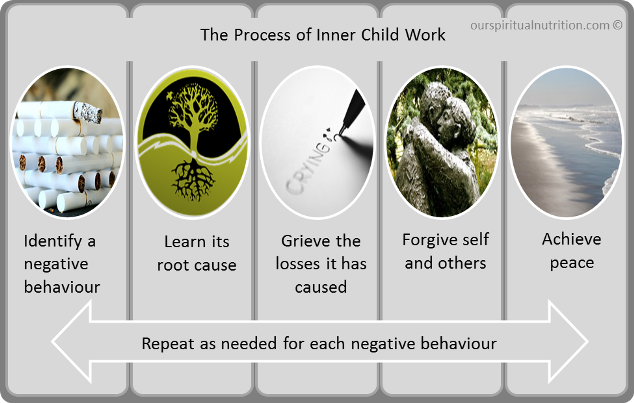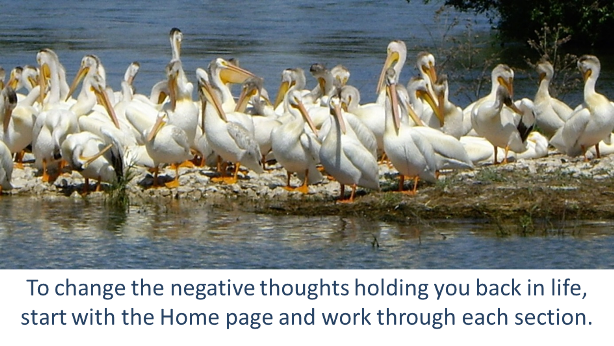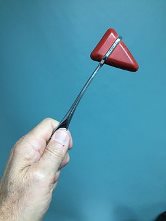Section 2 - Changing our automatic responses
No ads, fees or memberships. Ever.
About this page
Android phone - Tap More. Select Find in page
Android tablet - Select menu in top right, select Find on page
iPhone or iPad, Chrome - Tap More. Find in Page
Mac - Command+F
Safari with iPhone - Tap Share icon, scroll to Find on page
Windows PC, Chromebook, LinuxCtrl+F
Automatic responses
Knee-jerk reactions
Order from chaos
Figure 07: Chaotic thoughts, attitudes and emotions
Build a relationship with your Inner Child
Build a relationship with your Guide
The process of inner child work
Figure 08: The process of inner child work
Figure 09: Inner child work fits all my pieces together
About belief systems
Parental or caregiver issues
Addictions
Next step
Self-test
Automatic responses
The key to changing our automatic responses to our daily life experiences is to discover our reasons for choosing to respond the way we do. Those reasons can be found deep within our childhood memories and require focused effort to reveal. Inner child work is the practice of recovering the memories and resolving the issues they created. This initiates the spiritual decluttering process. Begin by building a relationship with your inner child, and then with your guide. See Section 8 if you need help to recall details about your childhood.
Order from chaos
When our thoughts are filled with negativity (chaos), it can be challenging to find peace and calm (order). When something is worrying or angering us, it can be almost impossible to stop thinking about it. The thought keeps endlessly repeating and after a while, we may not even hear it anymore - but it is still repeating. Without resolution, these often-repeated thoughts create accidents, illness and chronic confusion for us by lowering our vibrational frequency and keeping us stuck in feedback loops, to say nothing of creating karmic situations.
Resolving our inner conflicts frees our conscious mind to dwell in the current moment. We can focus on the matter at hand and this improves our memory, our ability to concentrate, and our ability to solve problems.
Figure 07: Chaotic thoughts, attitudes and emotions
Build a relationship with your Inner Child
Start doing things to support and honour yourself and to encourage self-expression. Do the things that you loved to do (or wished you could do) as a child: drawing, colouring, finger-painting, running, playing skip-rope or hopscotch, hula-hooping, writing in a diary, or whatever gave you comfort and/or joy. Use your imagination. These activities will help your inner child to feel acknowledged, respected, safe and secure. Aim to do this at least once or twice per each week, even if only for 30 minutes or an hour. Whatever you do, try to memorialize your thoughts and experiences by journaling.Build a relationship with your Guide
We are accompanied in life by our guide/teaching angel who is a messenger of God; a divine representative. The guides are the bridge connecting us with the Universal Intelligence. Nothing escapes their notice. Nothing in our experience is ignored or overlooked. Our thoughts are every bit as audible to our guide as the spoken word is to us. In fact, our entire life experience is recorded in our akashic record.
Learning to communicate consciously with our guide, by asking questions and, just as importantly, by listening for answers, opens the door to finding the root causes of our negative behaviours. Armed with this knowledge, we become able to resolve the difficulties in our lives and begin to meet our soul’s purpose.
The process of inner child work
Identify a negative behaviour
The first step is to identify any negative behaviour that causes problems for us. Could be addictions, chronic lateness, verbal sniping, withholding communication as a punishment, pathological lying, feeling like a victim, or any pattern that you wish you could change.
This can be challenging, since we can tend to feel fully justified in doing whatever we are doing. Until we accept that we are not perfect; that we do things that hurt ourselves and others; and that our motives may not always be pure, we remain unable to change. Learning the root cause of negative behaviours can also be challenging since our childhood memories are not always complete or accurate. This is where our guide can help.
Learn its root cause
The second step is to recall the traumatic event that triggered the negative pattern. This can be challenging if we dismiss an event simply because it was not necessarily traumatic in the clinical sense, or if we believe that early childhood events cannot be recalled. Ask your guide to show you the event while in a meditative state, and then pay attention to your thoughts. They will reveal your original reaction to the event. Your body is likely to feel how you felt then. Download the spiritual questionnaire if you need help to recall details about your childhood.
Note: If the thought pattern that drives a negative behaviour is not changed, the behaviour will manifest at the next triggering event.
Figure 08: The process of inner child work

Recall the thoughts, attitudes and emotions that you felt when it happened. Recall the decision that said, "I am going to (fill in the blank)". This could be something as simple as “I am never going to cry again” or as complex as “I am not worthy of respect or love” or “I am bad”. The decision you made then is the root cause that continues to create negativity in your life because it was made without understanding. Unresolved experiences tend to replay in our thoughts as we continually try to figure out why they happened. We get triggered whenever we are reminded either of the event, or of the conclusion we drew from it. Inner child work enables us to learn our motivations and validates our painful experiences. It also helps us to see that we were not solely responsible for their occurrence because after all, as children, we are simply not responsible.
Work with your guide to gain full understanding about why the event happened, why you reacted in the way that you did, and why you continue doing the behaviour. As adults, we can look at our childhood experiences and find understanding that is not possible for young children. This is not to place blame, but to accept responsibility for our part and to recognize that, as children, we were not solely responsible for their occurrence.
Grieve the losses it has caused
The third step is to feel the emotions and think the thoughts that could not be expressed as a child. Grieve the losses that were felt, and say the angry thoughts out loud, if possible. Cry, cry, cry. Let it all out, as scary as that may sound, for crying is an important part of the physical (and spiritual) healing process. Unresolved, repressed or suppressed issues create harmful toxins in the body and crying provides an escape route for them. Acknowledge the pain that made us choose to react the way we did, without understating its importance.
These events were important, for they have made us who we are today. It does not matter whether anyone else thinks that our experiences were easier or worse than theirs. What is important is that they happened to us, they hurt us, they were traumatic for us. All our experiences have helped to create all the thoughts, attitudes and emotions, beliefs and inner conflicts that we have now, that are creating our negative behaviours.
Forgive
The fourth step is to forgive, both self and others. This is a crucial action. Without forgiveness, we remain stuck in the past, constantly replaying unresolved experiences in our thoughts, hoping that somehow we will be able to figure out why they happened, or that we will be able to magically transcend the experience just by remembering it.
Food for thought
Doing this work enables true ‘freedom of thought’ because we free ourselves from repeating the thought patterns that create negative life patterns.
Achieve peace
The final step is to appreciate the peace that comes from resolving an issue. Revel in it, and use the satisfaction as a reason to keep on working on yourself. Then it will be time to identify another negative behaviour and repeat the process.
Doing this self-work changes the ways in which we interact with others, and our family and friends may be less than enthusiastic when uninvited change is thrust upon them. However, do not wait for anyone’s permission or approval before starting this work. This is your life; this is your choice; only you may decide what is right for you.
Identify another negative behaviour
Identify another negative behaviour and repeat the process. After all, we all have more than one bad habit. The reasons for our behaviours are multiple and intertwined, so there is always more understanding to be gained. Keep working toward inner peace and enlightenment.
Not doing this work puts us at risk for developing many chronic diseases, but don’t just take my word for it. Science is now proving that traumatic childhood experiences impact our health in adulthood.
Our core belief systems are incredibly powerful. Our self-esteem depends on them; they determine how we interpret and experience life. We begin forming them in childhood and our innate confirmation bias ensures that we continue to find them to be true.
Inner child work roots out negative or inaccurate beliefs (and thoughts, attitudes and emotions) and reveals the Universal Truth about them, rather than what we have come to accept as truth. Looking back on our childhood as adults, we can recall the thoughts we had as young children and find validation. Here is an example of what can happen if inner conflicts are left unresolved:
Parental or caregiver issues
Many experiences we have as children are written off by our caregivers as being unimportant, or the Truth of our experiences can even become wrapped in their denial. Thus their issues can become our issues (see legacy family patterns). We can end up believing that we are wrong or crazy or even just plain bad, causing many of our inner conflicts. We can take on their behaviours, in effect becoming a mirror for them and, as we all know, no one likes to see how we ourselves act. This mirror effect can cause a lot of turmoil in families, along with inner turmoil and unresolved inner conflicts for us.
It is up to us to validate ourselves by learning our responses to our painful childhood experiences, and seeing how they form the very foundation of our lifetime. Meditation enables us to become strong and confident by ensuring our beliefs are based in Universal truth, rather than someone else’s potentially biased (in their favour) version of our pivotal life events.
Addictions
Since addictions begin as thoughts which in turn create behaviours, they can be modified, and even, in certain cases, released completely. To bring about such dramatic change requires great strength, determination and commitment, but change is possible. Until the root cause of the need for the addiction has been recognized (see the process of inner child work), resolved and released, the likelihood of recurrence exists. Very often, the root cause is the belief "God must hate me" (see unconditional love), and therefore I deserve to be punished. Excessive gambling can be caused by a chronic need to win, to prove "God loves me".
Breaking an addictive habit
Those who have tried to ‘break’ a substance addiction or a self-destructive habit may have noticed their habit is not just one habit. Let me explain. Thanks to joining a months long gradual cessation program provided by my provincial lung association, I can share my story as a Formerly Addicted Cigarette Smoker.
The association provided a wealth of helpful information which I read and took to heart, so I was prepared as well as I could be for the process about to unfold. Participants were to keep track of each cigarette they either had, or craved but didn’t have, noting the time, severity of the craving and possible reasons for wanting it. This was a new concept for me, as I was not exactly the most observant person when it came to paying attention to myself. Sure enough though, I began to see that I wanted to smoke at certain specific and even predictable times... with a cup of coffee, after meals, when starting and finishing a phone call, when starting the car’s engine, etc. This was not just one, but many habits. I saw too that smoking had become part of my reward system; even in the midst of physically demanding tasks I would stop for a smoke because after all, I deserved a ‘reward’, when what I actually needed was to just rest for a few moments. This observation practice enabled me to start thinking of myself as a non-smoker, which is a vital component of the process of change - seeing ourselves in the new and improved way.
Last smoke
About two months after starting the program, I was tiring of recording every cigarette. On Halloween of 1986, I had a huge argument with my mother. The moment we ended the call, I badly wanted a cigarette. As I sat smoking and pondering what information to record, it occurred to me that the argument was important. While I didn’t have the knowledge or foresight to examine this further than to say well, there’s no way I’ll give my mother that much power in my life, I decided, firmly, ‘this’ was the last cigarette for me. Over the next few days and weeks, I noticed my cravings would come after increasingly longer periods and last for fewer seconds. Like waves on the ocean, the first few days saw one every three hours or so. Luckily the program had prepared me for this, so I was able to ‘just say no, not now’ and the craving would pass. This gradually stretched to three days, then weeks, then months. I was amazed to have a craving - seemingly from out of the blue - three years after my last smoke. It lasted not even a full second, and since then, I haven’t had a single desire to smoke.
Spiritual withdrawal symptoms
Now here’s the tricky part. I mentioned cravings above, and certainly, cravings play an oversized role in changing thought patterns and behaviours. Whether we’re trying to give up certain substances or change negative behaviours though, cravings are very likely to happen. Another, possibly even larger challenge than giving up the substance or the behaviour, is dealing with the increase in obsessive thoughts about the issue(s) we are unable or unwilling to confront and resolve.
When changing behaviours, our brain kicks into high gear and reminds us of all the reasons we want and need that thing, but that is not all. Our thoughts obsessively return to the underlying issues creating our need, our trigger events, and everything will remind us of our pain, the pain of the hurts we can’t bear to face (or worse, we have been trained to ignore or deny). The temptation to use that thing can feel overwhelming, and that’s if we’re paying attention to our thoughts. If we are not, we’re likely to experience even stronger and longer-lasting effects and cravings.
For example, someone with abandonment issues (see abandonment, fear of abandonment, reverse abandonment) is apt to recreate the very issues their addiction enables them to manage. Abandonment issues might cause us to pick a fight with a loved one so they (a) blow up at us, giving us an excuse to leave the relationship, (b) leave the relationship thereby proving we are in fact unlovable, or (c) and this seldom happens, they will lovingly soothe and comfort us. In this case, the addiction is the need to receive regular, ongoing proof and confirmation we are loved and appreciated. Any information to the contrary causes our knee-jerk reaction of lashing out. We might suffer brain freeze, rendering us incapable of calm or coherent thought, making the situation worse. But we don’t have to give in or give up. We have tools... We have re-trainable brains. We have information. We have free will.
Next step
The next step on the path to spiritual awareness is learning to meditate in a new way.
Self-test
Click buttons to show or hide content...
- Identify a negative behaviour or physical condition
- Find its root cause
- Grieve
- Forgive
- Identify another behaviour or condition and repeat the process
|
Got questions, comments or suggestions? |
Cookies
This site uses Statcounter web analytics to track statistics using a 3rd party analytics cookie. No personal information is stored in the cookie. To set a Refusal cookie for your web browser, visit statcounter.com
© Copyright: Sheila A. McBeath 1999
ISBN 978-1-7753521-2-9
If you print, reproduce or use any of this information, do not alter the content, and acknowledge "Making Change in Our Lives (a workbook)" within your material.
Pay it forward
If the spirit moves you, please donate to your favourite charity or perform community service.
Terms of use
The information in this website and/or e-book is provided as spiritual information only. It is not to be used or relied upon for medical diagnosis or treatment. Consult your healthcare provider before making healthcare decisions. Your use of this web site and/or e-book means that you accept these terms.
Last Updated 20250210
page top ↑
page end


